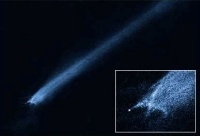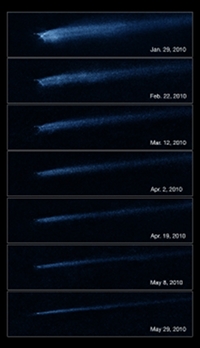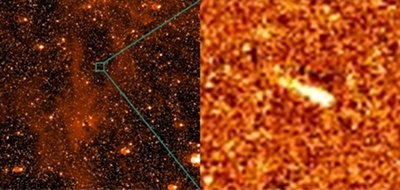Hubble and Rosetta unmask nature of recent asteroid wreck
13 October 2010
High-resolution images from the Hubble Space Telescope and a rare view obtained, from a unique perspective, by the Rosetta spacecraft provide a comprehensive picture of P/2010 A2, a puzzling body in the asteroid main belt. Although similar in appearance to a comet, this object and its diffuse trail have been exposed as the remnant of an asteroid crash that happened only one and a half years ago. These observations, reported in the 14 October issue of Nature, provide the first direct evidence for a recent collision in the asteroid belt.On 6 January 2010, the LINEAR survey of near-Earth asteroids detected a peculiar object in the main asteroid belt, between the orbits of Mars and Jupiter. The newly detected body, which was seen to have a diffuse trail of material emanating from it, was more similar in appearance to a comet than to an asteroid and was thus designated P/2010 A2, according to the rules of cometary nomenclature.
There are two well-known comet reservoirs, the Kuiper Belt and the Oort Cloud, both of which lie beyond Neptune's orbit. A recently discovered class, the Main Belt Comets (MBC), represents a third population of comets, which originate in the main asteroid belt. To date, only four MBC are known and, at first, P/2010 A2 was suspected to be a new, fifth member.
An image of the asteroid P/2010 A2, taken with the Hubble Space Telescope on 29 January 2010. Credit: NASA, ESA and D. Jewitt (UCLA)
"It was clearly an object that deserved special attention," explains David Jewitt from the University of California at Los Angeles, who recognised the baffling nature of P/2010 A2 and secured observations with the NASA/ESA Hubble Space Telescope. The orbit of P/2010 A2 lies in the inner asteroid belt, which is populated by rocks, not icy bodies like comets. "We guessed that this was not a regular comet produced by ice sublimation, and thought that it might be the result of a collision between two asteroids," continues Jewitt.

Early Hubble observations, obtained at the end of January 2010, showed an unusual appearance for a comet. Comets typically have a fan-shaped tail of gas and dust — the so-called coma — originating from a nucleus embedded within it; P/2010 A2, instead, displays a long and thin tail, with parallel sides, which is slightly detached from the nucleus and comprises a curiously X-shaped filamentary structure.
At the same time, this bizarre object attracted the attention of Colin Snodgrass and collaborators at the Max Planck Institute for Solar System Research (MPS) in Katlenburg-Lindau, Germany. They considered an alternative approach to study P/2010 A2: as a target of opportunity for ESA's Rosetta spacecraft.
In early 2010, Rosetta was about to approach the asteroid belt for its rendezvous, in July, with the asteroid Lutetia 21, a scientific target along the spacecraft's 10-year-long route to the comet Churyumov-Gerasimenko. "As Rosetta's orbit is tilted with respect to that of P/2010 A2, we realised that we had a rare opportunity to view this object from a unique angle," explains Snodgrass. Such a favourable perspective cannot be achieved from Earth, since our planet's orbit lies approximately in the same plane of the asteroid belt.
"After assessing the feasibility of adding this unanticipated task to Rosetta's schedule, we decided to seize the opportunity that nature offered us," comments Rita Schulz, Rosetta Project Scientist. "And we are very satisfied with the remarkable results that have been obtained," she adds.
The images gathered by the OSIRIS Narrow Angle Camera on board Rosetta provide a unique perspective which is complementary to the ground-based and Hubble observations. These data allowed astronomers to reconstruct the three-dimensional shape of P/2010 A2's diffuse trail in great detail, showing that it does not arise from cometary activity, as previously suspected, but consists of debris from a recent collision.
"This object is definitely not a comet, but an asteroid hit by another rock fragment in the crowded environment of the main asteroid belt," explains Snodgrass. The collision must have happened some time early in February 2009; Snodgrass's team's best estimate is within a 10-day window of 10 February. The impact resulted in the ejection of dust and led, initially, to the formation of a moderately-sized cloud around the nucleus; after a year, the Sun's gravity and radiation pressure contributed to spreading it to a more pronounced, and thus observable, extent.
This is the first direct evidence for a truly recent asteroid collision. Asteroids are expected to collide frequently, but so far only remnants of impacts that happened thousands to millions of years ago had been observed. In the case of P/2010 A2, the collision is so fresh that the debris tail is still evolving. The collisional nature and the estimated impact date have also been supported by further Hubble data, collected between January and May 2010.
 |
|
Hubble images of the asteroid P/2010 A2 at eight epochs between 25 January and 29 March 2010. Credits: NASA, ESA and D. Jewitt (UCLA) |
"We compared these images with results of dynamical models that describe emission of dust by comets and asteroids," says Jessica Agarwal, a former ESA post-doctoral fellow in the Research and Scientific Support Department at ESTEC, in the Netherlands. "The Hubble data show no current dust emission: the material was ejected at a single epoch in the recent past, most likely during a collision," she explains. Comparison with models also provided an estimate of the diameter of the nucleus of P/2010 A2, of about 120 metres, and of the projectile body, of only a few metres.
The detection of P/2010 A2 is likely to become the first of a series of extraordinary discoveries. Collisions between asteroids of this size happen approximately once per decade in the main belt; next-generation surveys of potentially hazardous asteroids will be sensitive to even fainter objects, which are remnants of the more frequent impacts between smaller asteroids, and are thus expected to reveal many more asteroid wrecks in the future.
Related publications
Snodgrass, C., et al., "A collision in 2009 as the origin of the debris trail of asteroid P/2010 A2", Nature, 467, 814-816, 2010. DOI:doi:10.1038/nature09453
Jewitt, D., et al., "A recent disruption of the main-belt asteroid P/2010 A2", Nature, 467, 817-819, 2010. DOI:10.1038/nature09456
Notes for editors
P/2010 A2 was discovered by the US Airforce LINEAR survey on 6 January 2010 and reported to the IAU Minor Planet Center in Boston. The object was originally announced with a comet designation (the "P" in P/2010 A2 means periodic comet, or from the Kuiper belt), but it was soon realised that it has an asteroid orbit, with semi-major axis a=2.29 AU.
It was later observed by several ground-based observatories, including the Kitt Peak National Observatory, the 3.6-m New Technology Telescope (NTT) at ESO's La Silla Observatory, and the 200'' Hale telescope at Palomar Mountain.
The Hubble Space Telescope data were gathered on eight occasions (25 and 29 January, 22 February, 12 March, 2 and 19 April, 8 and 29 May 2010) under Director's Discretionary Time proposals 12053 and 12077, using the Wide Field Camera 3 (WFC3).
Following its discovery, P/2010 A2 was quickly identified as a target of opportunity for Rosetta and was imaged by the OSIRIS Narrow Angle Camera on 16 March 2010.
Contacts
David Jewitt
University of California, Los Angeles,
California, USA
Phone: +1-310-825-2521
Email: jewitt ucla.edu
ucla.edu
Colin Snodgrass
Max Planck Institute for Solar System Research
Katlenburg-Lindau, Germany
Phone: +49-5556-979-358
Email: snodgrass mps.mpg.de
mps.mpg.de
Rita Schulz
ESA Rosetta Project Scientist
Research and Scientific Support Department
Directorate of Science and Robotic Exploration, ESA, The Netherlands
Phone: +31-71-565-4821
Email: rschulz rssd.esa.int
rssd.esa.int
Jessica Agarwal
Former ESA Research Fellow
c/o Clare Bingham, Research and Scientific Support Department
Directorate of Science and Robotic Exploration, ESA, The Netherlands
Phone: +31-71-565-3553
Email: clare.bingham esa.int
esa.int



